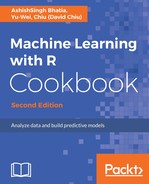In this recipe, we first used the predict function to obtain the predicted labels of the testing dataset. Next, we used the table function to generate the classification table based on the predicted labels of the testing dataset. So far, the evaluation procedure is very similar to the evaluation process mentioned in the previous chapter.
We then introduced a new function, classAgreement, which computes several coefficients of agreement between the columns and rows of a two-way contingency table. The coefficients include diag, kappa, rand, and crand. The diag coefficient represents the percentage of data points in the main diagonal of the classification table, kappa refers to diag, which is corrected for an agreement by a change (the probability of random agreements), rand represents the rand index, which measures the similarity between two data clusters, and crand indicates the rand index, which is adjusted for the chance grouping of elements.
Finally, we used confusionMatrix from the caret package to measure the performance of the classification model. The accuracy of 0.9185 shows that the trained support vector machine can correctly classify most of the observations. However, accuracy alone is not a good measurement of a classification model. One should also reference sensitivity and specificity.
